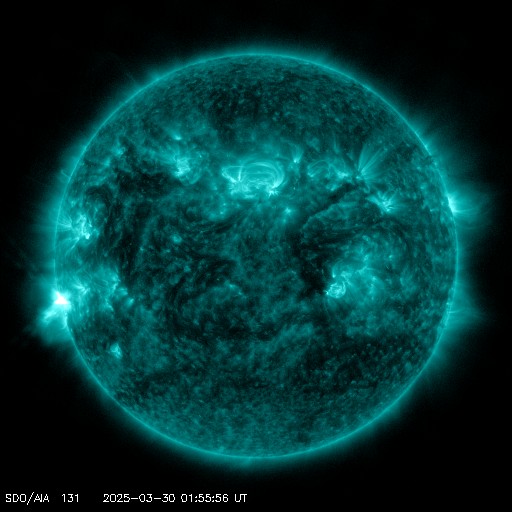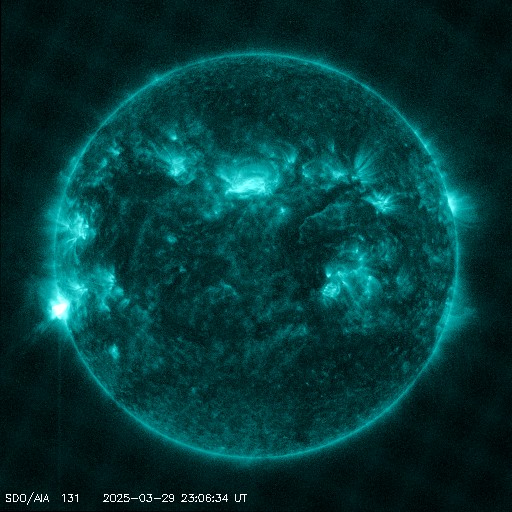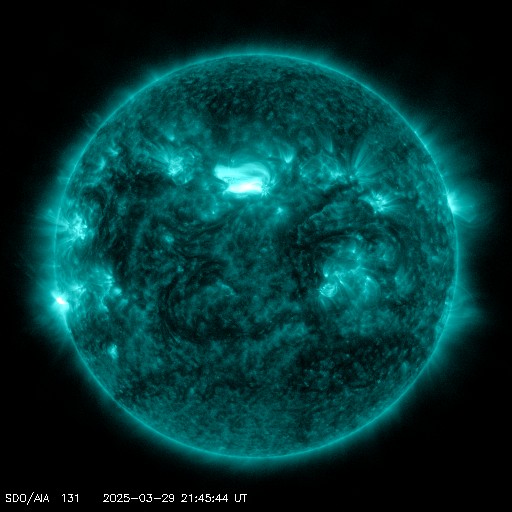Viewing archive of Tuesday, 4 September 2012
Solar activity report
Any mentioned solar flare in this report has a scaling factor applied by the Space Weather Prediction Center (SWPC). Because of the SWPC scaling factor, solar flares are reported as 42% smaller than for the science quality data. The scaling factor has been removed from our archived solar flare data to reflect the true physical units.
Report of Solar-Geophysical Activity 2012 Sep 04 2200 UTCPrepared by the NOAA © SWPC and processed by SpaceWeatherLive.com
Joint USAF/NOAA Report of Solar and Geophysical Activity
SDF Number 248 Issued at 2200Z on 04 Sep 2012IA. Analysis of Solar Active Regions and Activity from 03-2100Z to 04-2100Z
Solar activity was low. Region 1564 (S14E14 -
Esi/beta-gamma) was the most active region, producing occasional
low-level C-class flares. It increased in spot count and area during
the first half of the period, but showed gradual spot and penumbral
decay during the latter half of the period. Region 1560 (N04W47 -
Eai/beta-gamma-delta) showed a slight decrease in spots and area,
but maintained a delta in its interior spots. No significant changes
were observed in the remaining spotted regions and no new regions
were numbered. No Earth-directed CME activity was observed during
the period.
IB. Solar Activity Forecast
Solar activity is expected to be low
through the period (05 - 07 September) with a chance for an isolated
M-class flare.
IIA. Geophysical Activity Summary 03-2100Z to 04-2100Z
Geomagnetic field activity ranged from quiet to minor storm levels
with major storm periods detected at high latitudes, all due to
residual CME effects. The greater than 10 MeV proton event at
geosynchronous orbit that began at 01/1335Z, reached a maximum of 59
pfu at 02/0850Z, and ended at 04/0625Z.
IIB. Geophysical Activity Forecast
Geomagnetic field activity is
expected to be at quiet to unsettled levels during days 1 - 2 (05 -
06 September) with a chance for active levels. This is due to the
arrival of CMEs observed on 02 September along with a co-rotating
interaction region in advance of a coronal hole high-speed stream
(CH HSS). The CMEs are expected to arrive around midday on day 1.
The CH HSS is expected to commence on day 2. Field activity is
expected to be at quiet to unsettled levels on day 3 (07 September)
as CH HSS effects subside.
III. Event Probabilities 05 Sep to 07 Sep
| Class M | 25% | 25% | 25% |
| Class X | 01% | 01% | 01% |
| Proton | 01% | 01% | 01% |
| PCAF | green | ||
IV. Penticton 10.7 cm Flux
Observed 04 Sep 138 Predicted 05 Sep-07 Sep 135/135/130 90 Day Mean 04 Sep 124
V. Geomagnetic A Indices
Observed Afr/Ap 03 Sep 023/040 Estimated Afr/Ap 04 Sep 012/014 Predicted Afr/Ap 05 Sep-07 Sep 010/012-010/010-007/008
VI. Geomagnetic Activity Probabilities 05 Sep to 07 Sep
| A. Middle Latitudes | |||
|---|---|---|---|
| Active | 20% | 15% | 15% |
| Minor storm | 05% | 05% | 01% |
| Major-severe storm | 01% | 01% | 01% |
| B. High Latitudes | |||
|---|---|---|---|
| Active | 15% | 15% | 15% |
| Minor storm | 30% | 20% | 25% |
| Major-severe storm | 30% | 25% | 20% |
All times in UTC
Current data suggests there is a slight possibility for aurora to appear at the following high latitude regions in the near future
Gillam, MB, Yellowknife, NTLatest news
Latest forum messages
AR4048 20AR4043 47AR4046 128Incoming & Unnumbered Active Regions 1658Aurora photography hints for those of us with smartphones 51
More topicsSupport SpaceWeatherLive.com!
A lot of people come to SpaceWeatherLive to follow the Sun's activity or if there is aurora to be seen, but with more traffic comes higher server costs. Consider a donation if you enjoy SpaceWeatherLive so we can keep the website online!

Latest alerts
02:09 UTC - Solar flare
Moderate M1.54 flare from sunspot region 4048
01:42 UTC - Radio Blackout
Minor R1 radio blackout in progress (≥M1 - current: M1.24)
Saturday, 29 March 2025
23:21 UTC - Solar flare
Moderate M1.91 flare from sunspot region 4048
22:51 UTC - Radio Blackout
Minor R1 radio blackout in progress (≥M1 - current: M1.1)
21:57 UTC - Solar flare
Moderate M1.45 flare from sunspot region 4048
Space weather facts
| Last X-flare | 2025/03/28 | X1.1 |
| Last M-flare | 2025/03/30 | M1.5 |
| Last geomagnetic storm | 2025/03/27 | Kp5 (G1) |
| Spotless days | |
|---|---|
| Last spotless day | 2022/06/08 |
| Monthly mean Sunspot Number | |
|---|---|
| February 2025 | 154.6 +17.6 |
| March 2025 | 127.5 -27.1 |
| Last 30 days | 127.5 -24.7 |





